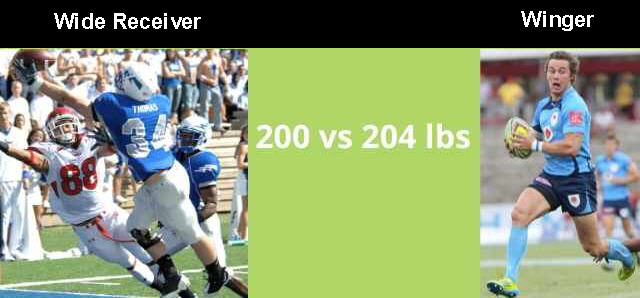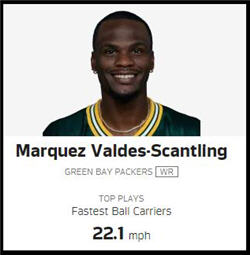I’ve crunched the numbers and came to these conclusions:
- NFL players are on average slightly faster than rugby players
- The fastest players in rugby are faster than the fastest players in the NFL
Wait. Does that seem contradictory? And am I comparing every position in the sports or just the most similar ones? And where did I get the numbers?
Read on, and I’ll explain why this is my opinion. Ultimately, it’s difficult to do valid comparisons as both sports use different measures to track speed.
Comparing NFL Wide Receivers To Rugby Wingers
For these comparisons to make sense, we have to try to compare like with like in terms of positions.
I mean, there’s no point comparing defensive tackles (the heaviest NFL position) to scrum-halves (the lightest on a rugby pitch).
So, the fairest comparison is to use the positions that clock the fastest times in both sports. It’s no surprise that both positions are the lightest on the field.

Fastest players in the NFL
In NFL, the fastest players are running backs and wide receivers.
The top ten fastest times published in 2021 by the NFL is made up of six wide receivers and four running backs. This is the source of my numbers in the next section.
As we show in our article on the average weight of wide receivers, this position has less bulk than others. This is due to the need for speed!
Fastest players in Rugby Union
In my opinion, the nearest equivalent in rugby to a wide receiver is the winger. And rugby centers are the equivalent to running backs.
Not surprisingly, the fastest players in rugby are wingers. You’ll find a breakdown of speeds for famous wingers in our article on how fast rugby players can run.
Unfortunately, I can’t find speed statistics for centers. So, this article compares the top speeds of wide receivers and rugby wingers.
NFL Players Are Slightly Faster Than Rugby Players (On Average)
In the table below, the first row has kilometers per hour. The second row has miles per hour.
The NFL number is the average top speed across the six wide receivers in the 2021 NFL list. The rugby number comes from the publication I linked in the previous section.
| NFL | Rugby | ||||
| Wide Receiver | 33.33 | km/h | Winger | 33.00 | km/h |
| Wide Receiver | 20.71 | mph | Winger | 20.50 | mph |
We can see that the NFL wide receiver average is slightly faster than the rugby number.
Is There A Fairer Comparison?
The comparison above is a little unfair to the rugby side.
The NFL average is based on six players drawn from the top ten speedster list.
In contrast, the rugby average is based on 20 countries participating in a World Cup. That is at least 40 wingers (I’m not sure if substitutes were included).
So, let’s take a look at the two fastest rugby players clocked at that World Cup.
We can compare them to the two fastest players on the NFL list. One is a running back, and the other is a wide receiver.
The Fastest Rugby Players Are Faster Than The Fastest NFL Players
England winger Jonny May clocked the fastest time at the Rugby World Cup 2019. Next up was Irish winger Jacob Stockdale.

The top two players in the NFL list of 2021 were Melvin Gordon of the Denver Broncos and Sammy Watkins of Baltimore Ravens. Gordon is a running back, while Watkins is a wide receiver.
Here’s a rundown in descending order of speed:
| Player | Team | km/h | mph |
| Jonny May | Gloucester (England) | 37.71 | 23.43 |
| Jacob Stockdale | Ulster (Ireland) | 35.80 | 22.25 |
| Melvin Gordon | Denver Broncos | 34.63 | 21.52 |
| Sammy Watkins | Baltimore Ravens | 33.88 | 21.05 |
The table shows that the two fastest rugby players of their generation are faster than the two fastest NFL players.
Challenge: Speed Tests Are Different Between The Sports
I’ve used the published top speeds for the comparison in this article.
You may be thinking that the average speed over a fixed distance would be better. But that is challenging due to the different speed tests used in the two tests.
Speed tests in American football

Speed tests are also a normal part of a player’s life in both sports. But to my eyes, they have greater importance in American football.
Young NFL draft prospects (aspiring players) must meet a minimum speed in a 40-yard dash test at specific events called Combines. The NFL publishes the numbers each year for the top ten performers.
It’s fair to say that NFL scouts and coaches put a massive emphasis on the 40 yard dash times.
This means that the 40-yard dash is used across all American college teams and professional franchises.
Speed tests in Rugby Union
Of course, speed is important in rugby too. But strength is more valued in the forwards.
Sure, it would be hard for a slower-than-average schoolboy to get a professional contract as a winger. But a talented youngster who lacks top speed can make it as a center.
There’s nothing like the 40-yard dash test in rugby. By this, I mean a speed test format that is performed by every club in a professional league.
Instead, there is a mix-mash of different types of shuttle runs adopted or devised by whatever head physio is at a particular rugby club at a particular time.
If you’re interested, check out our article on how rugby players train for speed.
Top speeds from GPS tracking

The reason that I used the top speed is that this is the same measure across both sports.
All NFL players wear some form of GPS tracker during a match. The trackers measure speed amongst other things.
Professional rugby was slower to adopt this kind of technology. I still hear older rugby fans wondering why there are bulges on the back of player jerseys!
But trackers are now normal in rugby at the elite level.
If you’re not familiar with GPS tracking, we have a full explanation in our article on GPS trackers in rugby.
Challenge: NFL Speed Statistics Are Easier To Find
Another challenge with comparisons between NFL and rugby is that NFL statistics are much easier to find.
In fact, the official NFL organization publishes detailed player statistics with every match through their NextGenStats technology.
They stream the numbers to broadcasters for real-time graphics up on the screen behind the commentators.
The NFL also has an area on their official website where they put up the latest numbers.
What about rugby speed statistics?
Rugby broadcasts also throw up plenty of stats on the screen. But the individual measures tend to be the number of tackles made or the number of meters made.
I’ve never seen top speeds flash up on the screen for the fifteen-player version of Rugby Union. Although I’ve heard commentators mention live stats in Rugby Sevens.
Most of the public statistics for rugby come from the private companies that provide GPS trackers to rugby clubs and international teams.
World Rugby is the governing body for Rugby Union in every country. You won’t find speed statistics on their website.
Out of curiosity, I checked the websites for the U.S. Eagles and for Major League Rugby (the North American professional competition). Have they followed the NFL example? No.
Challenge: Metrics Between The U.S. And Europe
When I look at the official NFL website right now, I see that a wide receiver for the Green Bay Packers hit a top speed of 22.1 mph.

So, here’s another challenge with making comparisons. I’m from Ireland. When I see a figure of 22.1 mph, I’m astonished.
Not by how fast that is, but by how slow!
Because “mph” reads to me as meters per hour. Even a slug would slide 22 meters in an hour (actually, I don’t know if that’s true).
But of course, “mph” here is miles per hour.
In contrast, speeds for European players are reported as km/h or kilometers per hour. So we have to do some conversions to make understandable comparisons.
Actually, that’s not a big deal. As long as someone else does the work. You’re welcome!